By Phil Bergman
INTRODUCTION
Rhapis humilis is a distinct and beautiful fan palm that is different than other species of this genus. It is also known as the tallest species of the genus. If one surfs the Net to learn about this species, one will get confused with the information found. Many people don’t know what the classic Rhapis humilis actually is. Although felt to be of Chinese or Taiwanese origin, no known plants have been found to exist in the wild. The assumption is that plants in the U.S. originated from private collections in China. The same applies to plants in Europe. Because of this, plants have been described almost entirely from known clumps either in botanical or private gardens. Plants found at the Huntington Botanical Garden in San Marino, CA were reportedly imported to that garden in the early 1900’s.

I have had communications on Internet discussion groups with growers in Asia who say that seed production of Rhapis humilis does occur in China. But, it is also mentioned that there are various “varieties” of Rhapis humilis, some short and others tall. And, with some of these varieties, there are females and seeds are produced. But, it’s unclear to me if plants in Asia are the same as what we see and describe here in the U.S. So, from one side of the world to the other, there are some different thoughts. But, no definitive publication on the larger Rhapis humilis now seen in California exists to my knowledge.
I would think that a taxonomist would become quite renowned for describing native habitats of this species and I have read no such reports. So, what I’m discussing here is what’s classically known as “Rhapis humilis” as observed on mature specimens in the United States. And, all these plants are domesticated plants. And, most of the known colonies are in California. It may be that all plants came from an original importation and that that plant was a male. Of course, this would lead to only male plants in offspring that found their way to other localities. If this is the case, one would feel that perhaps there are female plants somewhere in the wild. But, no colony or female plants have been found. If all domestic plants here came from one single plant, then all of course would be the same sex, male. And, perhaps all have their roots back to the plant at the Huntington. Unfortunately, no records exist to make this argument that I am aware of. With all this said we shall discuss what we can look at and appreciate – the plants that are in gardens here presently.

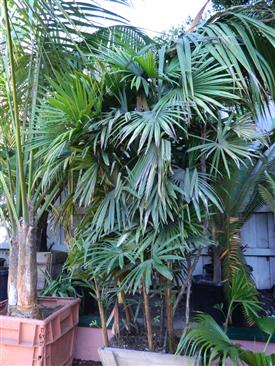
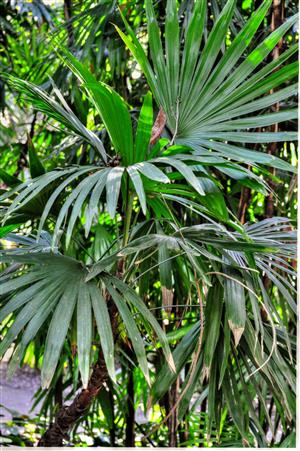
SPECIES DESCRIPTION
Rhapis humilis is a tall, thin trunked fan palm with many thin leaflets. Below I will compare it in many ways to the much more familiar and seen Rhapis excelsa, The Lady Palm. The first and most noticeable difference is that Rhapis humilis is a much taller plant. It easily gets to sixteen feet. I have personally seen plants well over twenty feet tall. Rhapis excelsa is typically half this height or less, although tall clones are known to exist. When younger, Rhapis humilis canes do carry a large amount of fiber, but with age stems lose fibers and become cleaner and more attractive than excelsa. Rhapis excelsa retain much more of the brown-black fibers. It remains unclear why Rhapis humilIs was given the name “Slender Lady Palm” as stem diameters of the two species are about the same.
Both average about an inch. Perhaps it’s because there are often fewer canes with humilis and foliage is often up and out of the way on a typical plant. So, when compared to Rhapis excelsa, canes of humilis can be more visible and on casual observation they appear narrow. But, perhaps this common name is more the result of cultivating nurseries selecting a name that would be easily remembered by consumers.
Another difference between these two Rhapis is that the leaves and leaf segments (leaflets) are different. Rhapis excelsa usually carries leaves with six to ten leaflets. In contrast, Rhapis humilis usually has at least a dozen leaflets or more. I’ve seen many plants with twenty or more leaflets. These leaf segments are also narrower than R. excelsa and at their distal end come to a noticeable point. Contrast this to the jagged and blunt endings of Rhapis excelsa. Plants sucker from their bases of both species. Also, the segments of Rhapis humilis tend to droop downwards at their ends. R. excelsa are more straight and stiff. With maturity and time, clumps of Rhapis humilis can expand to reach more than ten feet wide. With a healthy plant and good culture, newly formed trunks from the base fill in central areas of the plant with stems of various heights. Leaf color is dark green when in filtered light and more of a lime-green in full sun.

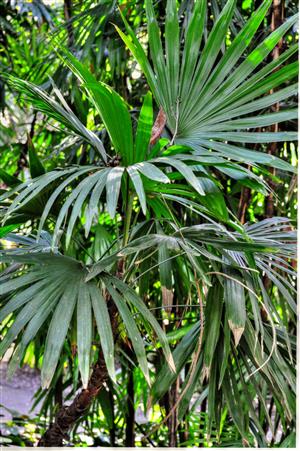
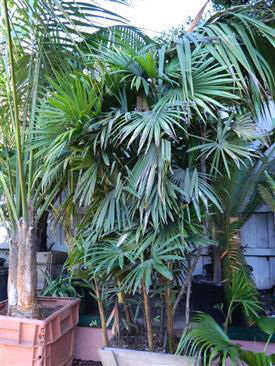
CULTURE OF RHAPIS HUMILIS
The Slender Lady Palm is not hard to grow but is slow growing. Obtaining mature height could take well over a decade. Rhapis humilis grows better in the ground than in a pot. Pots, especially when smaller, tend to restrict growth. Most would grow this species in filtered light. But, with time and maturity, as mentioned above, this species can obtain substantial height. Because of this it is not unusual to see clumps that have pierced overhead canopy and found themselves in full sun. And, they do quite well with this along the coast. In coastal areas, Rhapis humilis thrives in full sun. Rhapis excelsa usually does poorly in full sun. More inland and desert areas should grow both species in filtered light. Average watering is adequate on R. humilIs. But, they do not like to go dry. Brown tips to the leaflets can be caused by dehydration, salty water, too much fertilizer or extreme heat. Care must be taken not to over-fertilize this or any Rhapis, as all can burn from too much or too strong of a fertilizer program.
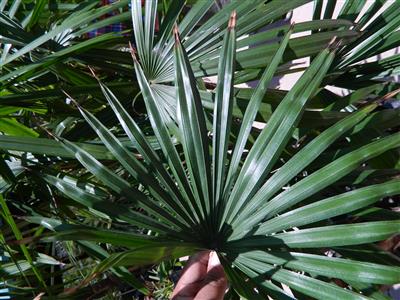
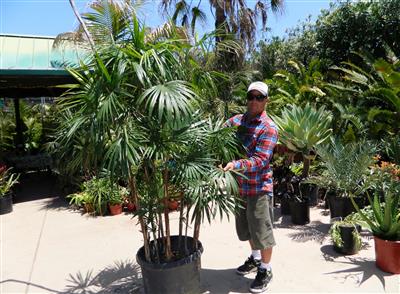
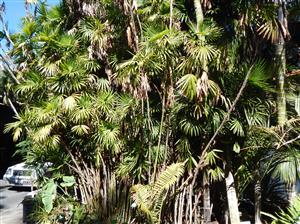
In terms of temperature, Rhapis humilis is fairly cold hardy and able to take temperatures into the low twenties F. or even colder. There are reports of it surviving 18 degrees F. It is a bit more cold hardy than Rhapis excela. It seems to like the cooler nights seen in Mediterranean climates compared to hot and sticky tropical weather. This species does not like extreme heat but tolerates temperatures into the 90’s F. Santa Ana conditions are hard on them and they prefer not to be in an overly hot greenhouse. In terms of potting soil, a sand based soil with adequate organics and good draining soil should work fine. Like other palms, the lowest leaves are the first to die and require removal by pruning. Trimming of brown tipped leaflets ends is an acceptable way to make the plant more handsome if needed.
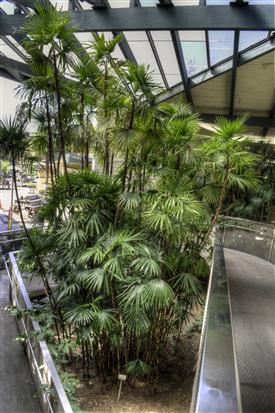
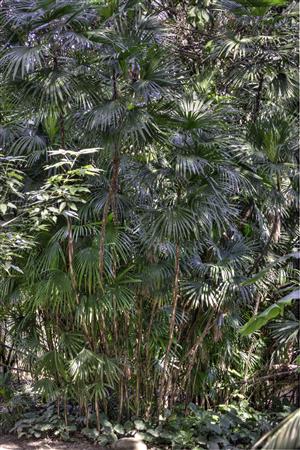
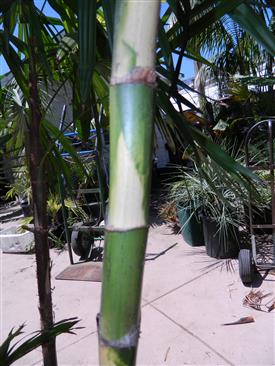
PROPAGATION OF THIS SPECIES
I was surprised to learn that, in the nursery industry, Rhapis multifida is often incorrectly called and sold as “Rhapis humilis”. So, be careful when you’re shopping for Rhapis humilis. I’ve been told this is done because people know and remember the name “humilis” but not “multifida”. But, these are two different species. R. multifida only gets to a height of about ten feet, has thinner canes and usually has a lesser number of leaflets per leaf. And, it doesn’t do well in full sun. Presently, as there are only males of Rhapis humilis known to exist, one can only obtain this species (as described here) by getting a division of an existing plant. There are no known seeds that exist. Beware of seed merchants who attempt to sell “Rhapis humilis seeds”. They are probably R. multifida or excelsa seeds. If you really want to obtain this tall Rhapis humilis, anticipate that it won’t be inexpensive and also be a division from an existing mother plant. Propagation by division is accomplished by careful dissection at ground level and below of an existing clump. With removal of superficial soil, underground attachments of the stems can be identified and cut with pruners. Then, with a shovel, the parts of the clump can be separated. Try to get division with multiple canes, at least three or four. This improves your chances for success. Removing single canes at a time is risky so try to avoid this. All successful divisions will eventually sucker out and make full mature trees.
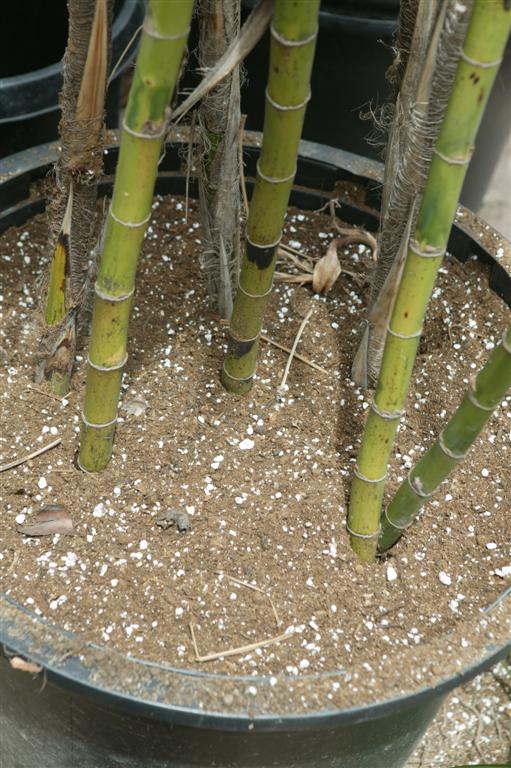
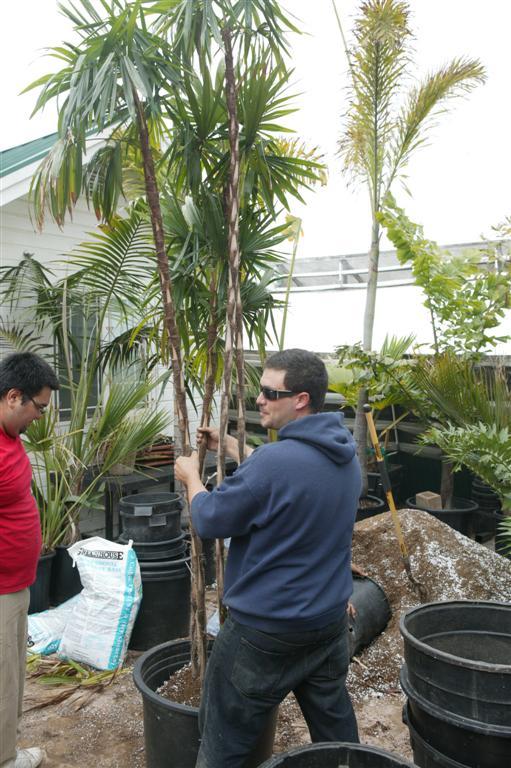

USAGE AS AN INTERIOR OR POTTED PALM
Rhapis humilis is a great species for interior planting if adequate ceiling height exists. Because of its size, it is quite popular in central areas of shopping centers, in hotel lobbies and commercial entryways. One can grow it in an average home but realize that taller canes would become a problem when they reach the ceiling. I would recommend growing it near a bright window. Usage of distilled or reverse osmosis water may lead to less brown tipping of the leaflets. It also does great in a container or decorative pot in patio areas. Plants do grow more slowly in pots and mature height may not be achieved. Outside, it can be put in filtered light or acclimated to full sun along the coast. Remember that plants twenty-five miles inland in San Marino, CA (Hunting Botanical Garden) are tolerating full sun. The Los Angeles Arboretum also has specimens seeing a large amount of sun.

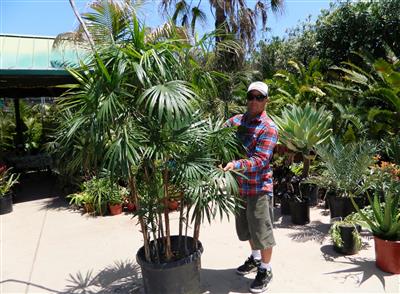

FINAL NOTES
I have heard mention of the “California Form” of this species. I’m not quite sure what this means. I think this term is used to describe what we see in California or other parts of this country, i.e. the very tall variety described here. As mentioned above, some Asian growers claim there are indeed different “varieties of Rhapis humilis”. Hopefully in the future there will be a definite and published work on Rhapis that will clarify confusions. Regarding the plants I’m describing here, I have seen at least twenty specimens of this palm species in California in areas spanning from San Diego to San Francisco. And, they all look quite similar; all are quite tall and none have been short. So, I’d say that the description above applies to and is typical of this species. Be aware that there are hybrids between the various species of Rhapis. And, this species is a great plant to use when doing hybridization. But, I will not discuss this here. Photos with this article show the typical appearance of Rhapis humilis in domesticated gardens. I consider it a great species for any Southern California garden. For photos I wish to give my thanks to FM, KT and REY.
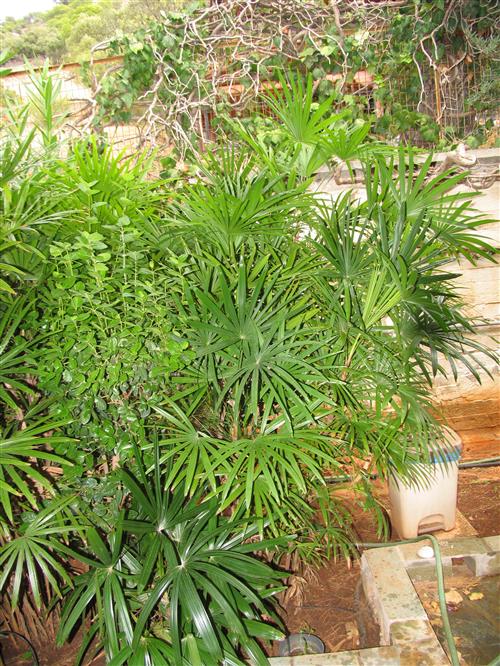
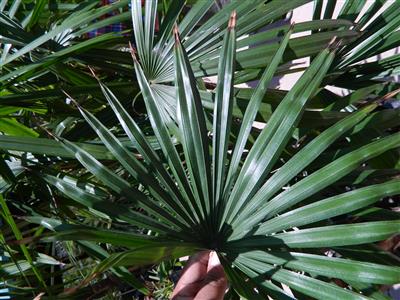
Phil Bergman
Jungle Music Palms, Cycads and Tropical Plants
- PALM TREES, CYCADS & TROPICAL PLANT BLOG - October 1, 2020
- TRACHYCARPUS
The Windmill Palm - September 30, 2020 - FAN PALMS –
PALMS WITH CIRCULAR LEAVES - September 29, 2020












